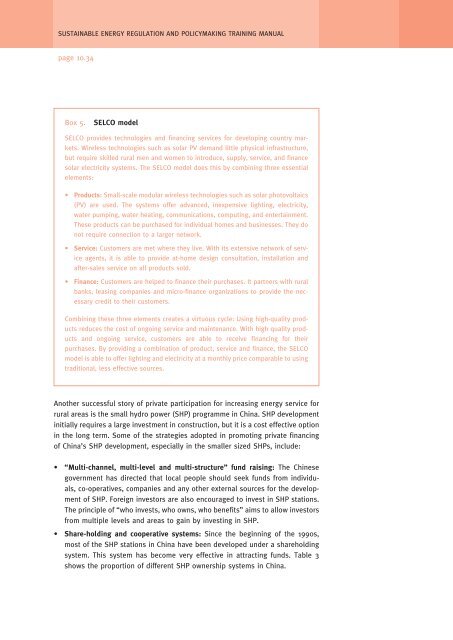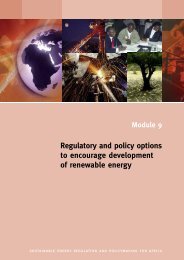Increasing access to energy services in rural areas - REEEP ...
Increasing access to energy services in rural areas - REEEP ...
Increasing access to energy services in rural areas - REEEP ...
Create successful ePaper yourself
Turn your PDF publications into a flip-book with our unique Google optimized e-Paper software.
SUSTAINABLE ENERGY REGULATION AND POLICYMAKING TRAINING MANUAL<br />
page 10.34<br />
Box 5.<br />
SELCO model<br />
SELCO provides technologies and f<strong>in</strong>anc<strong>in</strong>g <strong>services</strong> for develop<strong>in</strong>g country markets.<br />
Wireless technologies such as solar PV demand little physical <strong>in</strong>frastructure,<br />
but require skilled <strong>rural</strong> men and women <strong>to</strong> <strong>in</strong>troduce, supply, service, and f<strong>in</strong>ance<br />
solar electricity systems. The SELCO model does this by comb<strong>in</strong><strong>in</strong>g three essential<br />
elements:<br />
• Products: Small-scale modular wireless technologies such as solar pho<strong>to</strong>voltaics<br />
(PV) are used. The systems offer advanced, <strong>in</strong>expensive light<strong>in</strong>g, electricity,<br />
water pump<strong>in</strong>g, water heat<strong>in</strong>g, communications, comput<strong>in</strong>g, and enterta<strong>in</strong>ment.<br />
These products can be purchased for <strong>in</strong>dividual homes and bus<strong>in</strong>esses. They do<br />
not require connection <strong>to</strong> a larger network.<br />
• Service: Cus<strong>to</strong>mers are met where they live. With its extensive network of service<br />
agents, it is able <strong>to</strong> provide at-home design consultation, <strong>in</strong>stallation and<br />
after-sales service on all products sold.<br />
• F<strong>in</strong>ance: Cus<strong>to</strong>mers are helped <strong>to</strong> f<strong>in</strong>ance their purchases. It partners with <strong>rural</strong><br />
banks, leas<strong>in</strong>g companies and micro-f<strong>in</strong>ance organizations <strong>to</strong> provide the necessary<br />
credit <strong>to</strong> their cus<strong>to</strong>mers.<br />
Comb<strong>in</strong><strong>in</strong>g these three elements creates a virtuous cycle: Us<strong>in</strong>g high-quality products<br />
reduces the cost of ongo<strong>in</strong>g service and ma<strong>in</strong>tenance. With high quality products<br />
and ongo<strong>in</strong>g service, cus<strong>to</strong>mers are able <strong>to</strong> receive f<strong>in</strong>anc<strong>in</strong>g for their<br />
purchases. By provid<strong>in</strong>g a comb<strong>in</strong>ation of product, service and f<strong>in</strong>ance, the SELCO<br />
model is able <strong>to</strong> offer light<strong>in</strong>g and electricity at a monthly price comparable <strong>to</strong> us<strong>in</strong>g<br />
traditional, less effective sources.<br />
Another successful s<strong>to</strong>ry of private participation for <strong>in</strong>creas<strong>in</strong>g <strong>energy</strong> service for<br />
<strong>rural</strong> <strong>areas</strong> is the small hydro power (SHP) programme <strong>in</strong> Ch<strong>in</strong>a. SHP development<br />
<strong>in</strong>itially requires a large <strong>in</strong>vestment <strong>in</strong> construction, but it is a cost effective option<br />
<strong>in</strong> the long term. Some of the strategies adopted <strong>in</strong> promot<strong>in</strong>g private f<strong>in</strong>anc<strong>in</strong>g<br />
of Ch<strong>in</strong>a’s SHP development, especially <strong>in</strong> the smaller sized SHPs, <strong>in</strong>clude:<br />
• “Multi-channel, multi-level and multi-structure” fund rais<strong>in</strong>g: The Ch<strong>in</strong>ese<br />
government has directed that local people should seek funds from <strong>in</strong>dividuals,<br />
co-operatives, companies and any other external sources for the development<br />
of SHP. Foreign <strong>in</strong>ves<strong>to</strong>rs are also encouraged <strong>to</strong> <strong>in</strong>vest <strong>in</strong> SHP stations.<br />
The pr<strong>in</strong>ciple of “who <strong>in</strong>vests, who owns, who benefits” aims <strong>to</strong> allow <strong>in</strong>ves<strong>to</strong>rs<br />
from multiple levels and <strong>areas</strong> <strong>to</strong> ga<strong>in</strong> by <strong>in</strong>vest<strong>in</strong>g <strong>in</strong> SHP.<br />
• Share-hold<strong>in</strong>g and cooperative systems: S<strong>in</strong>ce the beg<strong>in</strong>n<strong>in</strong>g of the 1990s,<br />
most of the SHP stations <strong>in</strong> Ch<strong>in</strong>a have been developed under a sharehold<strong>in</strong>g<br />
system. This system has become very effective <strong>in</strong> attract<strong>in</strong>g funds. Table 3<br />
shows the proportion of different SHP ownership systems <strong>in</strong> Ch<strong>in</strong>a.










